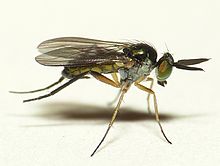Rhaphiinae
Appearance
| Rhaphiinae | |
|---|---|

| |
| Rhaphium appendiculatum | |
| Scientific classification | |
| Domain: | Eukaryota |
| Kingdom: | Animalia |
| Phylum: | Arthropoda |
| Class: | Insecta |
| Order: | Diptera |
| Family: | Dolichopodidae |
| Subfamily: | Rhaphiinae Bigot, 1852 |
| Genera | |
|
see text | |
Rhaphiinae is a subfamily of flies in the family Dolichopodidae.[1]
Genera
- Haplopharyngomyia Meuffels & Grootaert, 1999[2] (subfamily incertae sedis)
- Nematoproctus Loew, 1857[3] (Diaphorinae or Rhaphiinae)
- Ngirhaphium Evenhuis & Grootaert, 2002[4]
- Physopyga Grootaert & Meuffels, 1990[5]
- Rhaphium Meigen, 1803
- Urodolichus Lamb, 1922[6] (Diaphorinae or Rhaphiinae)
References
- ^ Yang, D.; Zhu, Y.; Wang, M.; Zhang, L. (2006). World Catalog of Dolichopodidae (Insecta: Diptera). Beijing: China Agricultural University Press. pp. 1–704. ISBN 9787811171020.
- ^ Meuffels, H. J. G.; Grootaert, P. (1999). "New names in the family Dolichopodidae (Diptera)e". Institut Royal des Sciences Naturelles de Belgique, Bruxelles (Belgium). Dept. Entomologie. 69: 289–292.
- ^ Loew, Hermann (1857). "Neue Beitrage zur Kenntniss der Dipteren". Funfter Beitrag. Progr. K. Realschule Meseritz 1857: 1–56.
- ^ Evenhuis, Neal. L.; Grootaert, Patrick (2002). "Annotated checklist of the Dolichopodidae (Diptera) of Singapore, with descriptions of a new genus and new species" (PDF). Raffles Bulletin of Zoology. 50 (2): 301–316. ISSN 0217-2445. Retrieved 23 July 2016.
- ^ Grootaert, Patrick; Meuffels, H. J. G. (1998). "Dolichopodidae (Diptera) from Papua New Guinea. IX, Mischopyga gen. nov. and Physopyga gen. nov., two new genera from the mangrove in Papua New Guinea" (PDF). Indo-Malayan Zoology. 6 (2): 195–206. ISSN 0168-6259. Retrieved 5 March 2017.
- ^ Lamb, C.G (1922). "The Percy Sladen Trust expedition to the Indian Ocean in 1905, under leadership of Mr. J. Stanley Gardiner M.A. Vol.VII. No.VIII-Diptera: Asilidae, Scenopinidae, Dolichopodidae, Pipunculidae, Syrphidae". Transactions of the Linnean Society of London. Zoology. 2. 18. London: The Linnean Society of London: 361–416. doi:10.1111/j.1096-3642.1922.tb00554.x.
